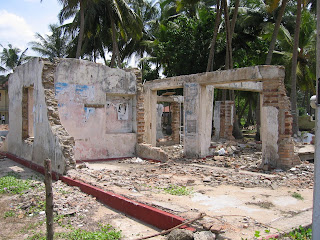
We pass an area of transitional housing. A year later and people are still living in transitional housing with no plan of moving them to permanent housing. These are nothing more than shacks and tents, unliveable, really. And, these stretch on for miles, side by side with the rubble and devastation. It reminds me of my time in Sierra Leone, but then I remember this was a tsunami that caused this and not bombs. Occasio
 nally, there ar
nally, there ar e placards where an organization or group of people came to construct a home. Signs that read “Danish Village”, “Spanish Village”, “Swedish Village” built by funds from those countries. I had heard over and over again from friends in Sri Lanka that the
e placards where an organization or group of people came to construct a home. Signs that read “Danish Village”, “Spanish Village”, “Swedish Village” built by funds from those countries. I had heard over and over again from friends in Sri Lanka that the y were tired of this “branding”. Imagine you lived in a village and now it is called the “Irish Village”. Imagine what that does to your sense of dignity.
y were tired of this “branding”. Imagine you lived in a village and now it is called the “Irish Village”. Imagine what that does to your sense of dignity.We come across an area that looks like it must be some sort of makeshift school. Indeed, Sunila says, it is. What do you do when the school isn’t really a standing structure and so many of the students and teachers have died? But, the kids I do see on Wednesday, are in uniform. Why? I ask. Sunila tells me the government has asked them to go back to school, to give the impression that life is moving on. But, Sunila asks, how can they go to school? Look at all this trauma they’ve experienced, look at the lack of infrastructure, there are no teachers! The children all look to me to be sitting around doing very little of much and in my cursory glance, it seems like they are waiting for class to begin. Waiting and waiting.
We pass an area where the road divides the sea from a lagoon. Nearby there are rail way tracks. Here some 3000 people were swept off the train tracks during their commute. Bodies from the sea washed into the lagoon. Sunila says that the lagoon hasn’t been properly dredged and they imagine that there are still bodies there.
We pass a mural done by some children. The parts written in Sinhala, Sunila tells me, tell of how the sea ravaged their lives. And then in English it says, “but we love the sea! You are our friend.”
There are black drums of water provided by the Red Cross. The water is not potable and the salinity levels in the ground mean it will stay that way for years.
Just a bit of background on Galle. During the late 80’s and through the 90’s Sunila tells me these were the worst times for human rights abuses. In the South, young men were systematically disappeared. Well, as Sunila points out, they weren’t typical disappearances because bodies were found, just not always identified. Bodies piled up by the side the road and set afire. Udaya told me earlier that he stopped going to university because of the disappearances/killings. Now, things have changed and Galle is no longer as hot as it once was… the disappearances have stopped. While we are in Galle to meet with the Creative Arts Center, colleagues of INFORM’s, the work they do demonstrates the juxtaposition of the war on the devastation of the tsunami. The offices of CAC are not far from transitional housing. All the CAC members that I meet have been affected by the tsunami. What strikes me most, Ravindra, Faisal and Farhana are so young! They’re all around 23 years old. Ravindra is a young Sinhala boy and Faisal and Farhana are young muslim girls. Sunila points out that it took so much courage for the girls to do the work of helping after the tsunami because their families disapproved.

Wednesday, February 22 marked the 4 year anniversary of the ceasefire agreement between the LTTE and the government. Today, we were here in Galle to support a peace rally. Given the history of Galle, this was an important place to have this peace rally. Moreover, Sunila tells me Galle is now a Sinhala, nationalist part of the country. All the more reason to ask for peace here. But, peace is threatening—so threatening that Ravindra is frantically calling around to confirm speakers, some of whom were too scared to get up and speak for peace publicly.
We march together with communities from areas around Galle into the town hall. Why is peace so threatening? As I’m observing this rally, I am beginning to get a glimpse into Sunila’s life and what she stands for. These people love her. She means someone who is committed to them and committed to peace. Peace threatens the Sinhala nationalists and the staunch LTTE because it means putting down weapons, it means accepting to agree. For this, Sunila’s life, members of her family’s lives have been threatened and friends have been killed.

We drive back in the evening and Sunila shares with me just how difficult it has been coming back to Galle. Her memories are vivid. She shares with me how she coped, the stories she told friends outside of Sri Lanka. The one that stays with me most vibrantly is this: women were most disproportionately affected by the tsunami. More women died, for cultural and social reasons and it can really make you angry. She told me of women hanging from trees because their long hair got caught, women’s bodies wrapped around barbed wire fences because their petticoats snarled in them.
(Sunila Abeysekera far left).

